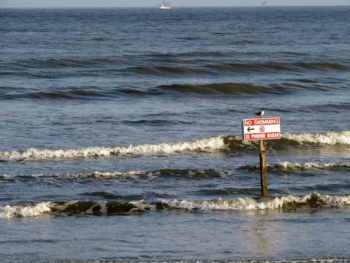Rip Current Survey Could Save Lives

Participating in a new Texas Sea Grant online survey about rip currents could someday save a life.
The survey is designed to determine the public’s knowledge about rip currents and the effectiveness of the current warning signs in use at surf beaches around the country. It was developed by Chris Houser of Texas A&M University and Rob Brander of the University of New South Wales with support from the Texas Sea Grant College Program.
Rip currents can occur at any beach with breaking waves, including the Great Lakes, and most often form at low spots or breaks in sandbars and near structures like piers, jetties and groins. According to the U.S. Lifesaving Association (USLA), more than 80 percent of the surf beach rescues performed by lifeguards each year involve rip currents.
They are not always easy to identify, but signs of rip currents include a break in the pattern of incoming waves; a channel of churning, choppy water; an area with a noticeably different water color; and a line of foam, seaweed or debris moving steadily seaward.
“The results of this survey will be used to determine whether our current efforts are visible, memorable and can be understood by beach users, or whether we need to rethink how to warn beach users of the rip danger before they enter the water. We hope that this information will help reduce the number of fatalities involving rip currents,” said Houser, associate professor of geography and associate dean for undergraduate affairs in Texas A&M’s College of Geosciences.
The survey is available here.
Rips are fast-moving currents of water that can pull even the strongest swimmer away from the shore. According to the USLA, rip currents account for at least 100 deaths each year at U.S. surf beaches.
The warning signs and other educational materials and activities, including National Weather Service surf zone forecasts and Rip Current Preparedness Week June 7-13, are part of the decade-long “Break the Grip of the Rip” public awareness campaign by USLA and the National Oceanic and Atmospheric Administration (NOAA).
The signs are illustrations designed to instruct people how to escape from a rip current if they become trapped in one, and show the rip from a bird’s-eye view rather than the perspective of someone on the beach.
“There have been an extraordinary number of rip current-related drownings already this year in the United States,” Houser said. “The number of drownings can be reduced through an increased presence of lifeguards and effective warning signs, but to our knowledge, no study has tested whether beach users are aware of the U.S. warning signs, or whether they comprehend the prevention strategy to ‘Break the Grip of the Rip’ and are able to translate the simple illustration of a rip current on the sign into a feature observable from the beach shore.”
The national online survey was inspired by an earlier in-person survey Houser and his Texas A&M colleague, Christian Brannstrom, professor of geography, asked of visitors to Texas beaches under a grant from Texas Sea Grant. Their study found that the “Break the Grip of the Rip” sign is mainly successful in describing what beach visitors should do when caught in a rip, but not successful in helping beach users identify rip currents from the perspective of standing or sitting on the beach before they enter the surf zone — more than half of beach users had difficulty translating the rip current image on the sign into a feature observable from the shore.
Houser and Brannstrom’s suggestions include redesigning the sign to include an eye-level photo of a rip current, adding information about the conditions and locations where rips occur, and listing the visible features that would help beach users identify rip currents.
If caught in a rip current, experts say don’t fight the current directly — swim out of it in a direction that follows the shoreline, then swim back to the shore once you are clear. If you can’t escape the current, float or tread water until the current stops, then swim back to shore. If you are still unable to reach shore, wave your arms and call for help. For greater safety, lifeguards say know how to swim, never swim alone, swim at beaches with lifeguards, and “if in doubt, don’t go out.”
More information about rip currents, including online training to help learn how to spot a rip current, is available from NOAA or USLA.
Media contact: Chris Houser, Texas A&M College of Geosciences, chouser@tamu.edu.





